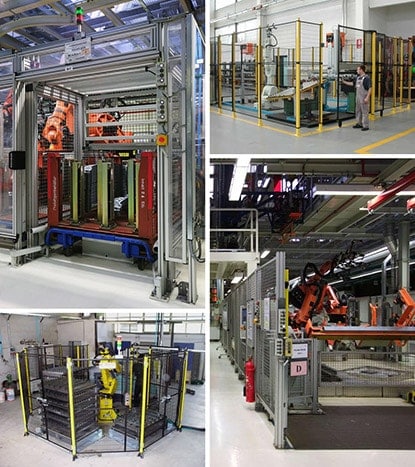Guide to Robot Cell Perimeter Guarding
Jeremy Procter, a Member of standards committees ISO/TC 199/WG 6 (Safety distances and ergonomic aspects) and BSI MCE/3 (Safeguarding of machinery), and Managing Director of Procter Machine Guarding, outlines the requirements for perimeter guarding of robot cells.
Industrial robots are playing an increasingly vital role in automated manufacturing, extending beyond the traditional automotive sector. However, ensuring the safety of personnel around these robots is paramount. In this comprehensive guide, Jeremy Procter, an expert in machinery safety standards, outlines the essential requirements for perimeter guarding of robot cells.
Understanding Robot Guarding Requirements

It is vital that perimeter guarding for robot cells is adequate and the correct guarding is selected for any given application
Robots in Manufacturing Industrial robots, once programmed, offer consistent and reliable performance. However, safety measures are essential to protect personnel from potential contact with the robot, its end-of-arm tooling, or payload. Additionally, the unpredictability of human actions and the possibility of technical issues demand careful consideration.
Perimeter Guards for Robot Cells
Perimeter guards are a fundamental aspect of ensuring robot safety. They are typically physical barriers, but alternatives like light guards, laser area scanners, and pressure-sensitive mats may be suitable for entry/exit points. Some applications even benefit from camera-based systems or roller shutter doors. Procter Machine Guarding offers the Talos High-Speed Roller Door, known for its versatility and optional viewing panels.
Reprogramming and Guarding
One advantage of robots is their ability to be reprogrammed for different tasks. However, each reprogramming requires a reassessment of the guarding to ensure continued safety. Modular perimeter guarding systems, such as steel and aluminum options, offer flexibility for these adjustments. Procter Machine Guarding provides both steel and aluminum choices, allowing unbiased recommendations based on specific applications.
Modular Steel Perimeter Guarding for Robot Cells
For projects requiring robust steel guards, SATECH STRONG, a heavy-duty modular system, is often recommended. In cases involving smaller robots, the Satech Basic modular perimeter guarding offers a cost-effective solution. These systems come with various specifications, including heights, widths, and color options, ensuring a tailored fit.
Compliance and Standards
When Procter Machine Guarding takes charge of specifying and designing steel or aluminum modular perimeter guards, they ensure compliance with EC and HSE requirements. Guards are CE marked or issued with a Declaration of Conformity, adhering to standards like BS EN ISO 12100, BS EN ISO 13855, and BS EN ISO 10218-2, among others. Compliance with HSG43 Industrial Robot Safety guidance is also considered.
Customized Solutions
Procter Machine Guarding goes beyond standard modular components, offering bespoke guarding solutions to fill areas where modular guarding may not suffice. These tailored elements seamlessly blend with standard components. Specialized protection for areas with forklift truck operations is also available to prevent costly downtime.
Your Partner in Robot Safety
Whether you require aluminum or steel modular perimeter guarding for robot cells, Procter Machine Guarding can also provide interlocks, safety light barriers, and pressure-sensitive safety mats. If you have prepared your layout designs, Procter can provide quotes for supply-only or supply-and-install services. Guard switches can be installed for easy integration into safety-related control systems.
If you are considering robot cell perimeter guarding, contact us to discuss your requirements, or explore our Perimeter Guarding section for more details and brochures.
